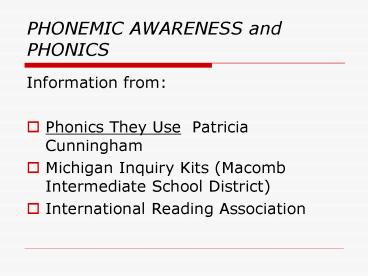PHONEMIC AWARENESS and PHONICS - PowerPoint PPT Presentation
1 / 18
Title:
PHONEMIC AWARENESS and PHONICS
Description:
Title: PHONICS AND PHONEMIC AWARENESS Last modified by: Joel Hyde Document presentation format: Custom Other titles: Gill Sans Verdana Times New Roman Wingdings ... – PowerPoint PPT presentation
Number of Views:223
Avg rating:3.0/5.0
Title: PHONEMIC AWARENESS and PHONICS
1
PHONEMIC AWARENESS and PHONICS
- Information from
- Phonics They Use Patricia Cunningham
- Michigan Inquiry Kits (Macomb Intermediate School
District) - International Reading Association
2
What is the difference?
- Phonemic awareness The awareness that sounds
(phonemes) make up spoken words. - Phonics The relationship between letters and
their sounds in written language.
3
Both are necessary
- They are part of the word identification process
of reading - If a child cannot hear the phonemes when spoken,
they most likely will struggle relating the
phonemes to letters when they see them in
writing. - (Another case for ELL learning needs above the
early elementary levels!!)
4
Phonemic awareness
- IRA definition
- Phonemic awareness is the ability to segment and
manipulate the sounds of oral language. It is
not the same as phonics, which involves knowing
how written letters relate to spoken sounds.
5
MLPP 2001 definition
- Phonemic awareness is the ability to separate
sounds that comprise spoken words. It involves
perceiving the relationships between sounds and
having the ability to alter and rearrange sounds
to create new words.
6
- Phonemic Awareness is the foundation of reading
and writing instruction. Children cannot
associate print a sound unless they can hear the
sound first. Furthermore, children cannot write
words until they have been taught to hear the
sounds within the words.
7
Phonological Continuum
- The child becomes aware of gross differences
between words. - The child becomes aware of rhyme.
- The child can segment words into syllables.
- The child is aware of initial consonant segments.
8
- The child hears alliteraton, or the awareness of
2 words beginning with the same sound. - The child is aware of onset and rime, single
phonemes with an end unit. - The child is able to break words into segments
(by syllables, onset/rime and into individual
phonemes)
9
- The child is able to blend sounds/phonemes.
- The child is able to manipulate sounds, but
additions, deletions, substitutions and
reversals. - Adapted from Literacy Assessment and Intervention
for the Elementary Classroom, B. DeVries,
Holcolmb Hathaway Publishers, 2004
10
PHONICS
- Phonics is the relationship between letters and
their sounds in WRITTEN language. - It cannot be effectively taught until phonemic
awareness is mastered.
11
- Phonics is a foundation skill of not only
decoding and vocabulary development in reading,
but also the foundation of spelling and writing. - Solid understanding of phonics unlocks the basics
of English language usage.
12
Phonics Continuum
- The child can identify the letters of the
alphabet. - The child is able to chunk groups of letters
together to read fluently. - The child is able to re-create the letter/sound
relationship in writing. - The child is able to use knowledge of
letter/sound patterns to expand decoding and
vocabulary.
13
Phonics to Word Study
- By the time a reader is transitioning to an
advanced level, phonics takes on more
sophisticated characteristics. - Syllabraic patterns need to be studied
CVC,CVCe,CVVC,CVCC,etc. - Morphemic units need to be studied
- (prefixes, suffixes, base words)
- Antonyms, Synonyms, Homophones need to be
studied.
14
Advanced Word Study
- By middle school and beyond, word study should be
replacing phonics to become a study in how words
are derived. - Etymology or the study of word origins (mostly
Greek/Latin word elements) need to be addressed. - Spelling patterns as a way to derive meaning
should be taught.
15
Whenever PHONICS/WORD STUDY is taught, it
- needs to develop alphabetic principle
- needs to develop phonological awareness
- needs to provide a thorough grounding in letters
16
- should lead to automatic word recognition
- should be ONE part of reading instruction
- should not teach just rules, or use only
worksheets - should give practice in reading words
17
At the Intermediate to HS levels
- Should study commonly misspelled words
- Should include word patterns
- Should include affix and syllable study
- Should include Greek/Latin roots
- Should not shy away from the commonly confused
words of the English language system (homophones,
synonyms, antonyms, homographs)
18
Advanced Word study
- Is a direct evolution from phonemic awareness and
phonics. The goal remains the same - To increase reading for meaning by dissecting
words at their simplest levels.































